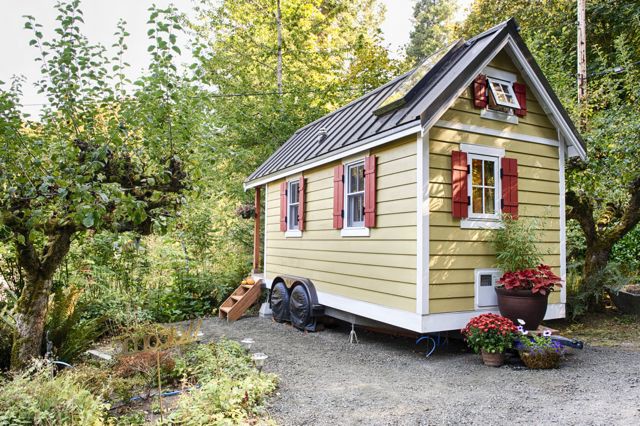By Eric Sims-Brown

Brittany Yunker tells me a story. She’s driving through a neighborhood with a thirteen foot pole attached to car. Sometimes she’s not driving, she’s walking with this thing she calls the “stinger.” I imagine the looks she gets are a mix of confusion and worry. Yunker is using her improvised measuring stick to see if her house will hit any trees or lampposts along the way.
Yunker is the owner of a 160-square-foot tiny house. She built the home herself even though her previous construction experience involved making a coat rack in the eighth grade. “The most challenging part was just persevering through all the questions, the questions I had about what were the next steps in the building process, the questions other people had – like where’s your poop going to go,” says Yunker.
The home is built on top of an 18-foot flatbed trailer. I can see Puget Sound through a skylight in the loft. The interior is surprisingly spacious and comfortable. There is no clutter, everything has its place. “I hate single use items,” says Yunker. “You could get this giant thing that crushes garlic for you or you could use a cutting board and knife.”
She isn’t judging. There simply isn’t enough room. Hence a shower but no tub or television or dishwasher. “I became more aware of things, places that were available for me in the community to fill a gap that comes with living in a tiny house. I could use internet at the library or the washer and dryer at my parent’s house,” she says.

Yunker no longer lives in her tiny house. She built it with one person in mind and has since found someone. She now rents her house out on a nightly basis. Her advice to anyone thinking about building a tiny house? “Take an open space in your living room and tape it off into sections. Just visualize one little three by three space is a bathroom.”
Yuri Bockwinkel is old-timey. The Evergreen student needs a unicycle or maybe a top hat. He sports an impressive handlebar mustache and an enthusiasm for tiny house living. Bockwinkel, a native of the Chicago area, is building his house this summer and plans to drive it back to Olympia.
Bockwinkel’s decision to live in a tiny house is based on a commitment to sustainable living. “In my small home, I know the impact of the materials and devices I have chosen. I won’t have to stress out about not knowing my true impact on the land.”
Living in a small space makes sense for a college student. So what happens later as plans change or as life expands? Bockwinkel has some ideas. “If I have children someday then I already have a playhouse for them. If I build a new home in the future, then I can have a tiny home as a guest house – or perhaps it will serve as an office.”
Creating often involves recreating. A writer can always make another draft. A chef can tweak a recipe. In these scenarios there is little time or money lost. The same can not be said for home construction. Bockwinkel grew up working with his hands – a skill he learned from his father. He mostly knows what’s he doing, but admits he’s still learning. “When I changed my heating plan, well, that changed the entire layout of the floor which changed my electrical plan which changed my frame. It is a complex system and I am still trying to fully understand it.”

Cathy Crane is a fourth grade teacher at Bordeaux Elementary in Shelton. Cathy and her husband Tim are thinking about building their own tiny house. One of the biggest reasons for the downsize is savings. They own their own home but, like a lot of people, are underwater on their mortgage. “We’d rent our house and live in the tiny house,” says Crane. The long term goal is debt reduction. “We’ve been working on paying off our debt so we could have some real freedom at some point.”
The Cranes are not alone. Says Cathy, “Tim works with people who are either doing something similar or know someone who is in the process of going tiny.” Tiny houses cost money but not nearly as much as traditional home. Brittany Yunker spent $17,000 to build hers. The upfront costs are absorbed over time because utility bills are small and there is little to no mortgage payment.
Of course there’s a tradeoff. The Cranes are both in their early fifties. They’ve spent years living a certain way. They have tools, appliances, pictures, assorted knicknacks and valuables that have value because of some shared experience or memory. “The hardest part will be designing good storage for our clothes and paring down our needs,” says Cathy.


































